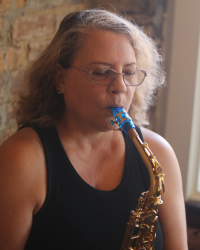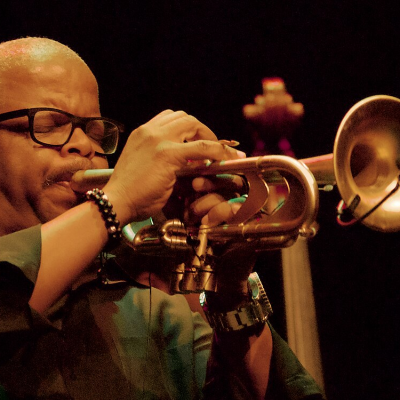.
.
“New York City Sax Heist” was a short-listed entry in our recently concluded 65th Short Fiction Contest, and is published with the consent of the author.
.
.
___
.
.
photo via PickPik

.
.
New York City Sax Heist
by Debbie Burke
.
…..Sally Sue Cordella might be the most famous alto sax player you’ve never heard of. The fifty-two-year-old Brooklyn resident recently came into possession of a 1964 Aristocrat—a quite rare horn, etched curiously with not just the usual scrollwork on the ligature and body but also with images of circus animals and a calliope at the end of the bell. The dubious origin story of entering Sally Sue’s possession, however, is a bit of a dark tale.
…..Steven Jay Price, who was wholly responsible for the afternoon-to-overnight programming on Brooklyn County Community College Radio Station WJZZ (some non-elites snickered at the crassness of the call letters; others felt superior for not snickering) saw the tiniest snippet in the “About Town” section of the New York Post and nearly choked on his lemongrass kale shake. It read:
A Brooklyn-bound cabbie who picked up a “determined-looking” woman in Manhattan’s Upper West Side was stunned when a passenger found an incredibly valuable saxophone in the back seat and refused to hand it over. “I never saw anything like this,” he said, clearly shaken up. “She seemed nice enough, but when I suggested she hand it over to me so I could track down the owner, she told me ‘no.’” His rude passenger then threw a ten-dollar bill over the front seat and got out at a red light, disappearing into the night. The police were called, but nothing could be done until they had more information.
…..Price knew he had to find this guest and put a plea out on the air. The daytime hosts also put the word out when they came into the studio.
…..As his luck would have it, all he needed to do was go on social media to see if anybody was bragging about having “found” the vagabond sax. A simple search (“lost sax NYC cab”) got an immediate hit.
…..Sally Sue Cordello responded to Price’s message on Instagram and agreed to come on the air, under one condition. No cops.
…..“Sure thing, Sally.”
…..“Sally SUE.”
…..At two in the afternoon the next day, Sally Sue set out for Brooklyn County Community College. Though technically only three miles away, she gave herself an hour (Brooklyn traffic being what it was) to find the entrance to the school and make her way to the right building.
…..As she approached the guard shack, she came to a stop, then rifled through her purse to get the security pass Price had emailed to her. The guard nodded. “You’ll go past the athletic field at your right. Communications is the third left from there. It’s a small building with a statue of the school logo in iron. You can’t miss it.”
…..He doesn’t know my sense of direction. It’s a miracle I got here in the first place, she thought.
…..Sure enough, the building came into sight with its ruddy letters: “BCCC.”
…..Price had called in a special favor from Neddy Johnson, the school’s burliest security guard. Though Price didn’t know if Sally Sue was or could be a threat, he knew one thing: anyone could make a weapon of an alto sax, in more ways than one. Better to be safe than sorry.
…..Sally Sue found the door with a peeling radio tower sticker on it and rapped three times. With a sharp intake of breath and a nod to Neddy, who was chilling with the latest copy of DownBeat, Price pulled the door open. “Sally Sue?”
…..She felt satisfied he had gotten her name right.
…..“Yes, it’s me.”
…..Price pulled the door back and let her in. A black plastic trash bag apparently with the musical contraband swung into the steel door with a clunk. Price tried not to look horrified.
…..When they settled into their seats, Sally Sue, who kept the bag on her lap, glared straight ahead. Not blinking, she asked, “So how does this work?” She turtled her head to get a better look at the mic, phallic and covered in protective foam, just inches from her face. She fought the urge to push it away, out of her bubble of space. A slight sneer tugged at the right side of her mouth. One more transgression, she thought, and I’m just out of here.
…..She softened when she realized Price was similarly crunched into his chair on the other side of a small steel desk with magazines and sticky notes of all hues. Calling the studio “modest” was an overstatement.
…..“Now remember, this is live, but with a seven-second delay. They used to call that a ‘profanity delay,’ so you get where I’m coming from.” He looked at his guest. No reaction.
…..“First I’ll introduce you to the listeners,” he continued. “I’ll frame it this way: you found a saxophone in a cab and today, you’re here with it to tell us your story. Sounds good?”
…..Sally Sue shifted in her squeaky chair. “Um.” She paused. “Okay. But you said no cops, not even campus security. So I’m free to tell it my way?”
…..Neddy was just outside, in the hallway, eyes shielded by wraparound sunglasses. He peered into the sound booth. With his left hand, he drummed some tune onto the carpeted walls, and with his right, he fingered the cell phone in the pocket of his nylon black vest. He gave a slow micro-nod, letting Price know he was watching everything unfold and he was at the ready to call in the troops if needed. Naturally, campus police had been told about Sally Sue’s visit and were in the building, while two uniformed city cops sat outside in their car, listening to WJZZ’s canned music. “I Remember Clifford” played while Price queued up the show.
…..“You are totally free to tell it your way.” Price smiled, happy that he was getting this scoop and determined not to blow it. It wasn’t so much that he wanted an on-air confession, though that would do a lot to solidify his bona fides. What Price really wanted was a look at this saxophone. Its owner, an iconic sideman and soloist who was a three-time National Endowment of the Arts Jazz Master, made a plea on almost every social media platform for its safe return in exchange for a healthy reward. Price wasn’t banking on the reward, but he did want to see the instrument. Maybe…she would let him try it out.
…..“And in five, four…” Price gestured the rest of the countdown with his fingers.
…..“Good afternoon jazz lovers all over the beautiful borough of Brooklyn and beyond! Today, we have a very special guest.” Price let some air out in a hiss. “You might have heard about the sax that was ‘misplaced’ by a very famous musician and that somebody found in one of our yellow New York City cabs. Well, the recipient of that interesting fortune is here. Today, we’re interviewing Miss Sally Sue Cordella. Thanks for coming in, Sally Sue!” He raised his eyebrows and lifted his chin for her to start.
…..“Good afternoon, Steven Jay!”
…..Price’s left eye twitched. “So let’s start right in with how you found this horn—”
…..“I think y’all know it’s an alto saxophone.” She drew the last two words out.
…..“Yes, well, generically, I sometimes refer to the sax as a horn. Or an axe. Or any number of things! But the one you found. Tell us, how did this get into your hands?”
…..“Thank you, and I must say this is a very small—dark, even—radio station. I’ve not been in a lot of them and had no idea they were this, uh, cave-like. Anyway, thank you for the privilege. And let me just say, this was a stroke of fortune! I never could have imagined this.” Sally Sue sat back in her chair, lips sealed.
…..This was not going to be an easy interview. Price was just hoping there was somebody, anybody, listening. At 3 p.m., it was not yet drive time for commuters, and their stats had shown sagging audiences at midday. Most people seemed to tune in right after the traditional US/East Coast dinnertime hour, wine or weed (or both) in hand. He knew this because of the comments on the surveys. And the streaming listeners tuned in mostly at nighttime and then overnight. Three in the afternoon was a sonic wasteland. Tells you how highly the college thought of jazz as an art form.
…..“What street did you get the cab on and where were you going?” he asked, tone hopefully encouraging.
…..“Oh, that! Those are the details you want. Okay!”
…..Neddy laughed into his hand and then gave his head a quick, hard shake. He pitied Price at this moment. He would definitely take the guy out for an IPA in Sheepshead Bay the next time they were both off. They were buds that way.
…..Price had only slotted in an hour for the interview, and the way things were going, it was looking like he wouldn’t even fill that up. He had plenty of chestnuts to play, though, in case she turned out to be a dud.
…..“I got into the cab at 87th and Amsterdam. I was coming from a nice little vegan restaurant that I ended up eating alone at. I was supposed to have a date there. Tinder, you’ve heard of it?”
…..Price blushed. Not because he knew the app well and had used it unsuccessfully for months (swearing he’d be giving it up), but at the embarrassment over her candor. It was TMI.
…..“I have. And so you hailed a cab?”
…..“Well, I ate first, anyway. Just because the schmuck was a no-show didn’t mean I couldn’t eat, did it?”
…..“Of course not.”
…..Maybe this would take the full hour. Maybe even more.
…..“So I had my dinner, I don’t think you need to know precisely what I ate, and then I started walking to the train station.”
…..“And where do you live?”
…..“Well, I don’t want to say.”
…..“That’s fair.”
…..“Marine Park.” She smiled ghoulishly.
…..Neddy turned his back on the booth and coughed. Price saw him slump down a little, laughing into his sleeve, then coming back up.
…..“So I almost got to the station. I saw the lights and was about to descend to the depths of subway hell, you know, haha!”
…..“Yes?”
…..“And I realized I felt safer in a cab. It was dark and cold and I just wanted to be delivered door to door. You know? Like, treat myself. Why not! I was just stood up. Self-care is everything.”
…..“And the cab, well, who pulled over?”
…..“Oh, a very nice gentleman. It looked like he was from the Middle East. But I don’t judge.”
…..Red flag number three or four (he’d stopped counting) was flapping wildly in the wind at this point. That seven-second delay was about to come in handy, but he was dreading having to stop the show. The streams had tripled in the past five minutes and continued to tick upward.
…..“I know you don’t judge, Sally Sue. You are a fair and might I say a very interesting person!” His hand was poised over the red button of silence, just waiting for the next gem to drop. “Tell me about what you saw in the back seat,” he prompted.
…..“I saw this beautiful serpentine sax, that you so crudely called a horn, on the back seat, sitting there, minding its own business. I gasped and must have said something out loud like ‘Ooh, who left this here?’ and before I could compose myself, the Irani, or maybe he was Arab or Jewish, I can’t tell. I hope I don’t offend anybody! But before I could stop myself, the cab driver who was headed south on Columbus Avenue—well, the light was still green and he actually turned around! I panicked, so I guess I kind of yelled at him to look out, for cripe’s sake.”
…..But did she steal it? mused Price.
…..“So I grabbed it by the neck and waited for him to stop at the next red light. Then I threw a bill at him, I don’t know if it was a ten or a twenty, because you know it’s illegal not to pay for your fare. I threw open my door and got out. We were in the middle lane, darn it, and I had to move fast before the light turned green. As it was, a bike rider nearly knocked me down.”
…..“What did you do from there?”
…..“I hate to admit it, but I walked to the next subway station and went home.”
…..“The sax? Was there a case?”
…..“No, it was just on the seat alone, naked, really, haha, so I hid it under my coat the best I could and jumped on the IND line. I live in a two-fare zone, as you know, so I have to take the Avenue R bus at the Kings Highway station to get back home. I’m not saying where I live, of course.”
…..“What did you think you were going to do with the saxophone?”
…..Sally Sue let out a short, bark-like laugh. “I mean, what do you think? You think I know how to play this thing? Here, you play it.” She shoved it at him.
…..This was his one and only chance. In a few minutes, the sax and its temporary owner would be scurried along in their journey. Gingerly, Price took it from her and stood it up on his leg. The etching was beautiful, unlike anything he’d ever seen. He played clarinet a little bit, and he knew the sax had similar fingering.
…..“Can I play it?” Even as he said it, he understood how bizarre the situation was. But why not give it a toot before it was confiscated? Which, by his estimation, was going to happen pretty damn soon. Neddy had messaged him that things were about to happen and it came up as a little popup on Price’s screen, which was turned away from Sally Sue’s line of sight.
…..He used a wet wipe to rid the reed of any of the big germs (leaving the small germs very happily intact) and licked it to coat it with his own funky DNA, then began to blow. The thing played itself. The sound was full, round, warm, incredible. And it was criminal evidence. Remembering this, he sampled a few bold arpeggios and then handed it back to Sally Sue.
…..“Whew! You sound great. Maybe you want this? I’ll sell it to ya. Ha!”
…..The clock read forty minutes down, ten more to go. Hopefully, the cops would be there in that slim window. Rounding out the hour would be some Charlie Parker and then some Turrentine.
…..Coordinating this was Neddy’s job. The man could be relied on 110% so Price knew the end was definitely in sight.
…..Sally Sue had no idea what was going to happen, but then again, technically speaking, neither did Steven Jay Price.
…..“I have one more thing to say.” She said it like it was a warning.
…..“Go ahead, we are all ears.” It was true. At this point, sixty-three thousand pairs of ears. Unbelievable!
…..“It’s just that, well, I know the owner misses his ‘horn,’ as you’ve called it.”
…..This woman’s elevator did not go to all the floors. That much was clear.
…..“And since I don’t even play the thing, well, I’m prepared to let it go for a reward. Say, ten thousand smackeroos?”
…..“Oh, Sally Sue, that’s not for me to decide,” he said flatly.
…..“Well, let’s put it out for the highest bidder, then! Turn your radio show into an auction and let’s get this happening! I don’t have all day.”
…..Sally Sue was looking agitated and frazzled. Price didn’t know how long he could keep this up.
…..Just then, the light of day streamed in from down the hall and in strode two city cops. Price hit his red button and switched on his pre-recorded message. He’d prepared two of them.
…..The first pre-recorded spiel was something about “running out of time” and was to be used in case things just went over the hour. Advertisers had paid for their spots and certain programming and he would need to continue the interview offline, record it, and play it at a later time.
…..The second message was to be used in case of something unexpected or violent, where he told the audience that due to technical issues, the interview had to be terminated. Which was the option he used, as they burst into the sound booth and helped Sally Sue to her feet. Waiting in the wings was the owner of the saxophone, who happened to be in town promoting his retrospective album. He wept when he saw his instrument and threw Price a look of disgust that he’d dared to play it, immediately followed by a smile of understanding what had transpired and that he himself would have done the exact same thing.
…..“So what do you think?” Benjy Grant asked Price. “Is she smooth or is she smooth?”
…..“Like an evening with a strong bourbon at a crackling fireplace.”
…..“A poet. We should collab sometime.”
.
.
___
.
.

Debbie Burke is an award-winning author of eleven books, including three jazz novels and the nonfiction interview series Tasty Jazz Jams for Our Times™. She studied alto saxophone at the New School for Social Research in 1987 and has played in several community jazz bands in Pennsylvania. In 2016, she started her jazz and photography blog at debbieburkecreative.com. She is also a professional editor and author coach at Queen Esther Publishing LLC, which she founded in 2020. Brooklyn-born, she now resides in Virginia Beach, VA.
.
___
.
.
Click here to help support the continuing publication of Jerry Jazz Musician, and to keep it ad and commercial-free (thank you!)
.
Click here to read “Ballad,” Lúcia Leão’s winning story in the 65th Jerry Jazz Musician Short Fiction Contest
Click here to read more short fiction published on Jerry Jazz Musician
Click here to read The Sunday Poem
Click here for information about how to submit your poetry or short fiction
Click here for details about the upcoming 66th Jerry Jazz Musician Short Fiction Contest
Click here to subscribe to the Jerry Jazz Musician quarterly newsletter (it’s free)
.
.
.
___
.
.
Jerry Jazz Musician…human produced (and AI-free) since 1999
.
.
.



































